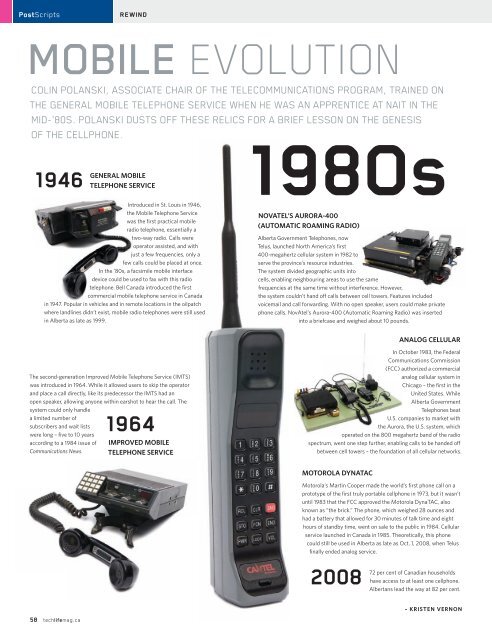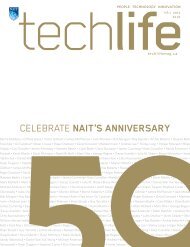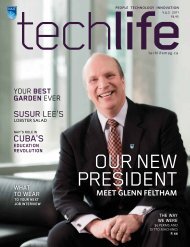techlifev2.2
Read the full print edition - techlife magazine
Read the full print edition - techlife magazine
- No tags were found...
Create successful ePaper yourself
Turn your PDF publications into a flip-book with our unique Google optimized e-Paper software.
postScriptsrewindMOBILE EVolutioncolin polAnSKi, ASSociATe cHAir oF THe TelecommunicATionS progrAm, TrAined onTHe generAl mobile TelepHone SerVice wHen He wAS An ApprenTice AT nAiT in THemid-’80S. polAnSKi duSTS oFF THeSe relicS For A brieF leSSon on THe geneSiSoF THe cellpHone.198osgenerAl mObile1946 telephOne ServiCeIntroduced in St. Louis in 1946,the Mobile Telephone Servicewas the first practical mobileradio telephone, essentially atwo-way radio. Calls wereoperator assisted, and withjust a few frequencies, only afew calls could be placed at once.In the ’80s, a facsimile mobile interfacedevice could be used to fax with this radiotelephone. Bell Canada introduced the firstcommercial mobile telephone service in Canadain 1947. Popular in vehicles and in remote locations in the oilpatchwhere landlines didn’t exist, mobile radio telephones were still usedin Alberta as late as 1999.nOvAtel’S AurOrA-400(AutOmAtiC rOAming rADiO)Alberta Government Telephones, nowTelus, launched North America’s first400-megahertz cellular system in 1982 toserve the province’s resource industries.The system divided geographic units intocells, enabling neighbouring areas to use the samefrequencies at the same time without interference. However,the system couldn’t hand off calls between cell towers. Features includedvoicemail and call forwarding. With no open speaker, users could make privatephone calls. NovAtel’s Aurora-400 (Automatic Roaming Radio) was insertedinto a briefcase and weighed about 10 pounds.AnAlOg CellulArThe second-generation Improved Mobile Telephone Service (IMTS)was introduced in 1964. While it allowed users to skip the operatorand place a call directly, like its predecessor the IMTS had anopen speaker, allowing anyone within earshot to hear the call. Thesystem could only handlea limited number ofsubscribers and wait listswere long – five to 10 yearsaccording to a 1984 issue ofCommunications News.1964imprOveD mObiletelephOne ServiCeIn October 1983, the FederalCommunications Commission(FCC) authorized a commercialanalog cellular system inChicago – the first in theUnited States. WhileAlberta GovernmentTelephones beatU.S. companies to market withthe Aurora, the U.S. system, whichoperated on the 800 megahertz band of the radiospectrum, went one step further, enabling calls to be handed offbetween cell towers – the foundation of all cellular networks.mOtOrOlA DynAtACMotorola’s Martin Cooper made the world’s first phone call on aprototype of the first truly portable cellphone in 1973, but it wasn’tuntil 1983 that the FCC approved the Motorola DynaTAC, alsoknown as “the brick.” The phone, which weighed 28 ounces andhad a battery that allowed for 30 minutes of talk time and eighthours of standby time, went on sale to the public in 1984. Cellularservice launched in Canada in 1985. Theoretically, this phonecould still be used in Alberta as late as Oct. 1, 2008, when Telusfinally ended analog service.72 per cent of Canadian households2008 have access to at least one cellphone.Albertans lead the way at 82 per cent.58 techlifemag.ca– KriSten vernOn










